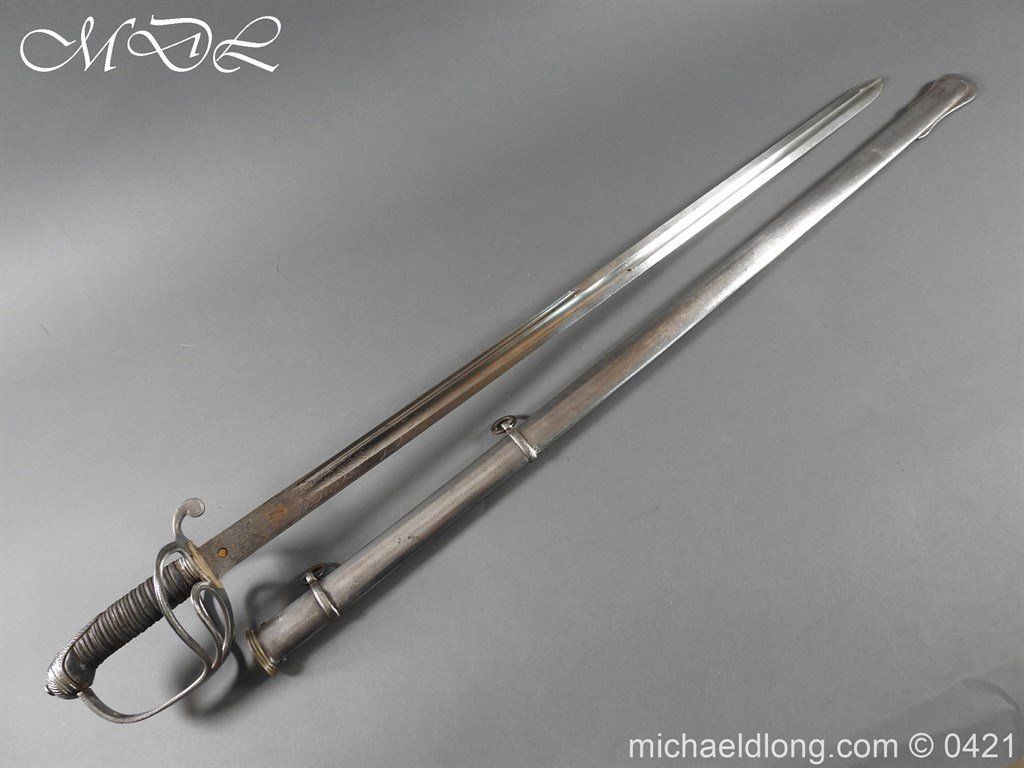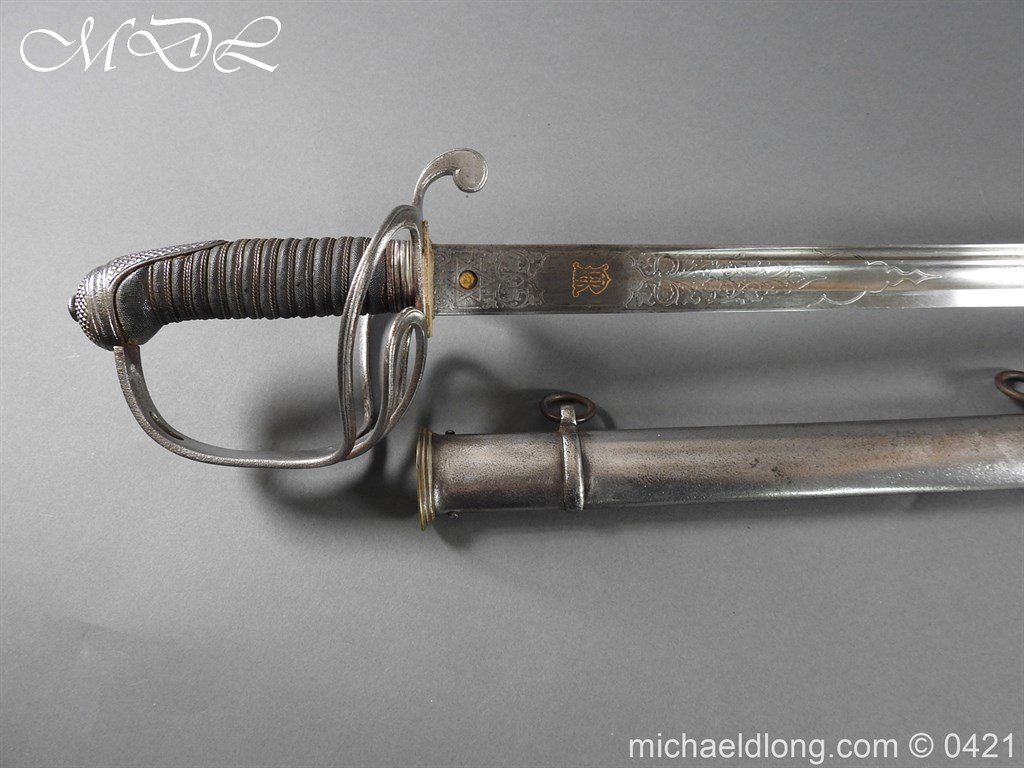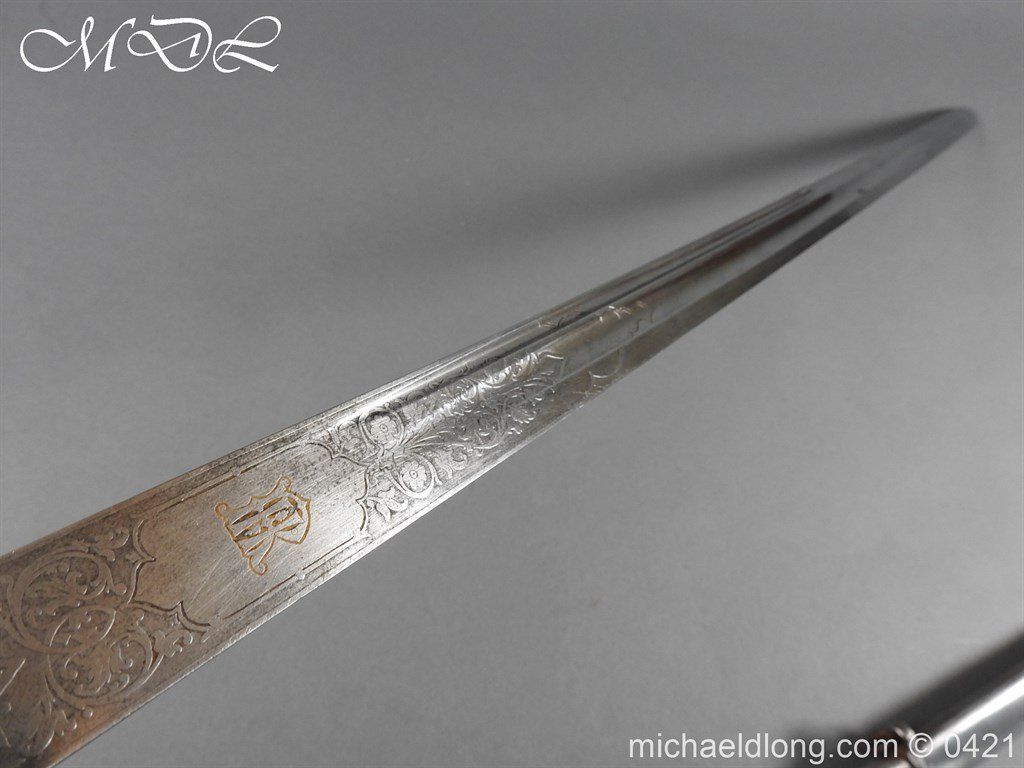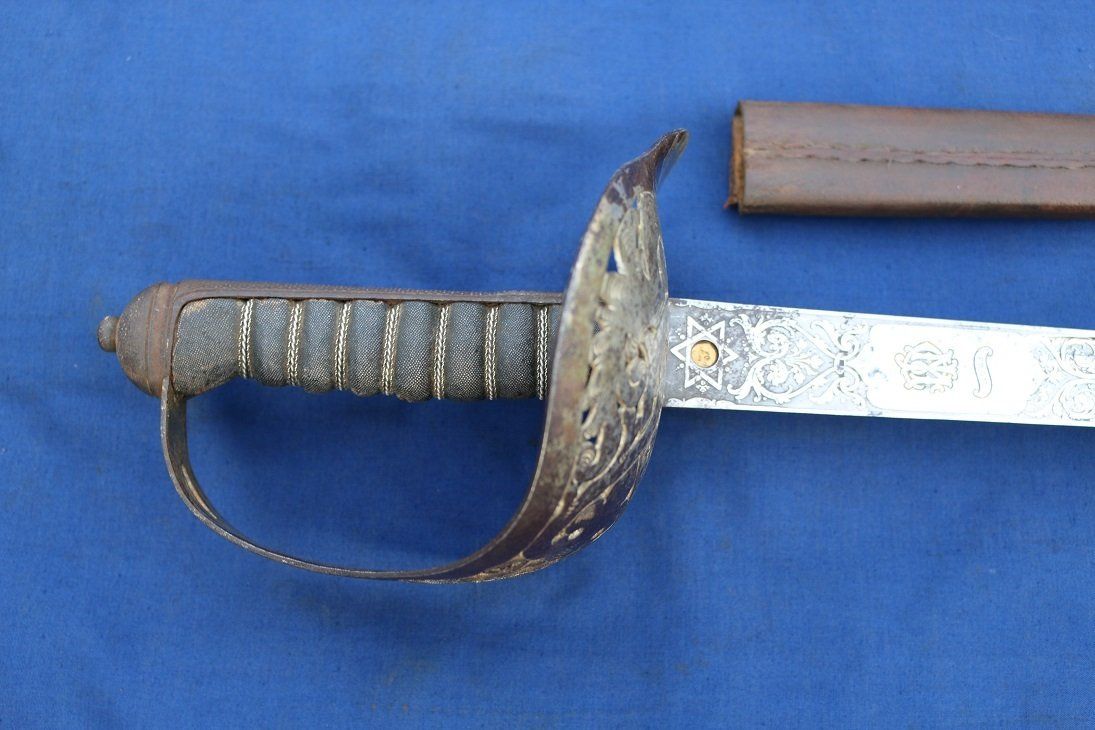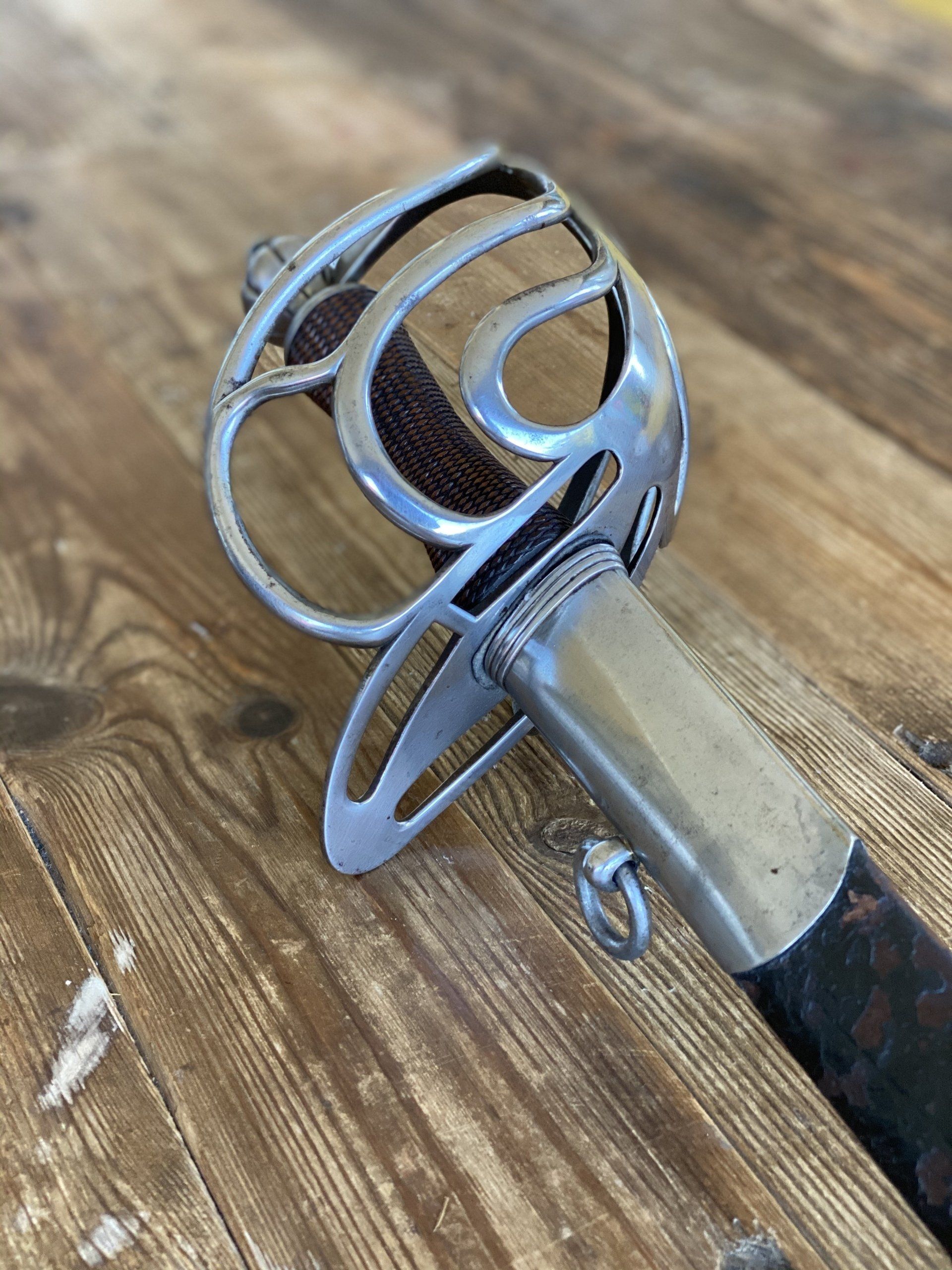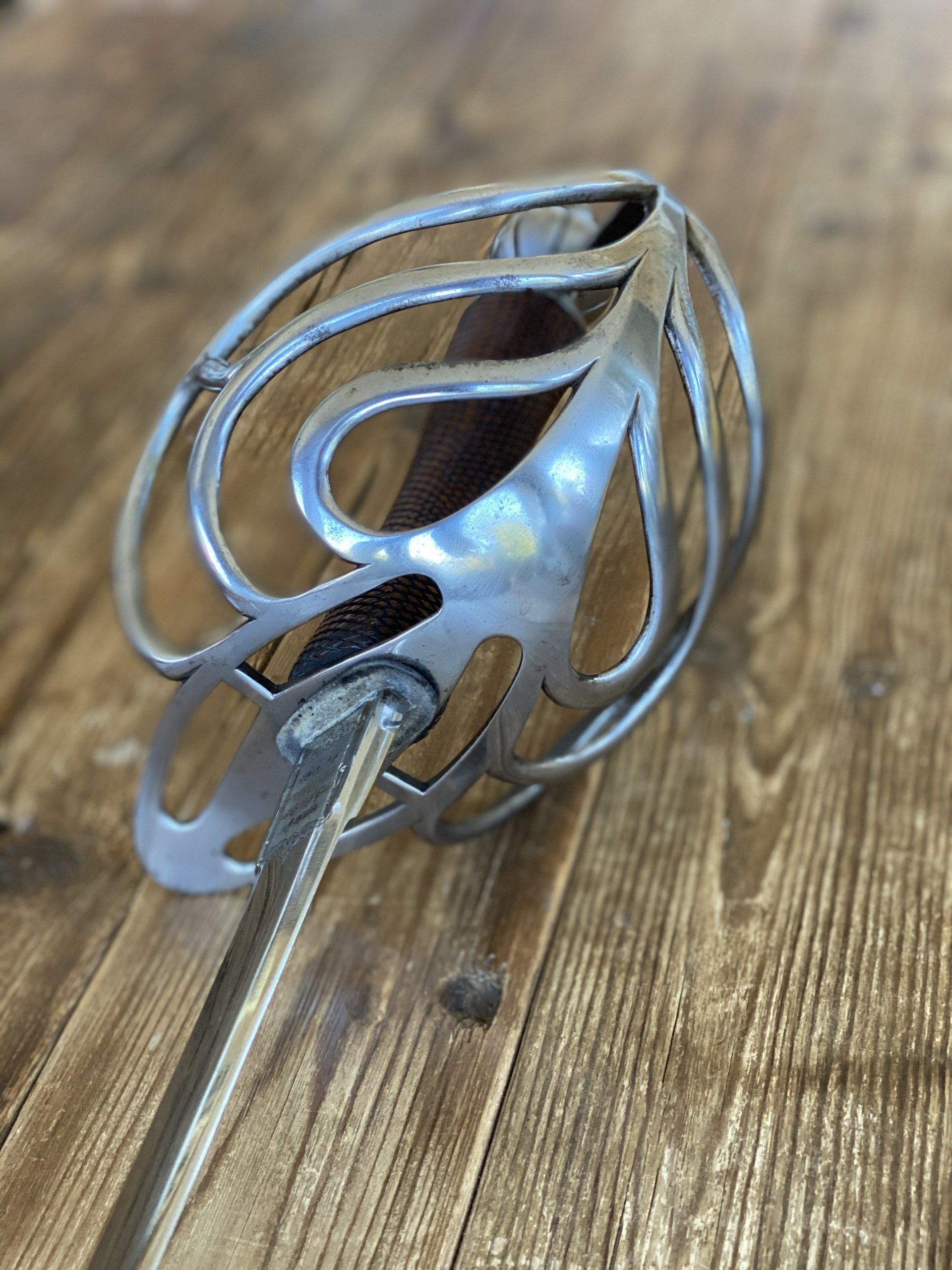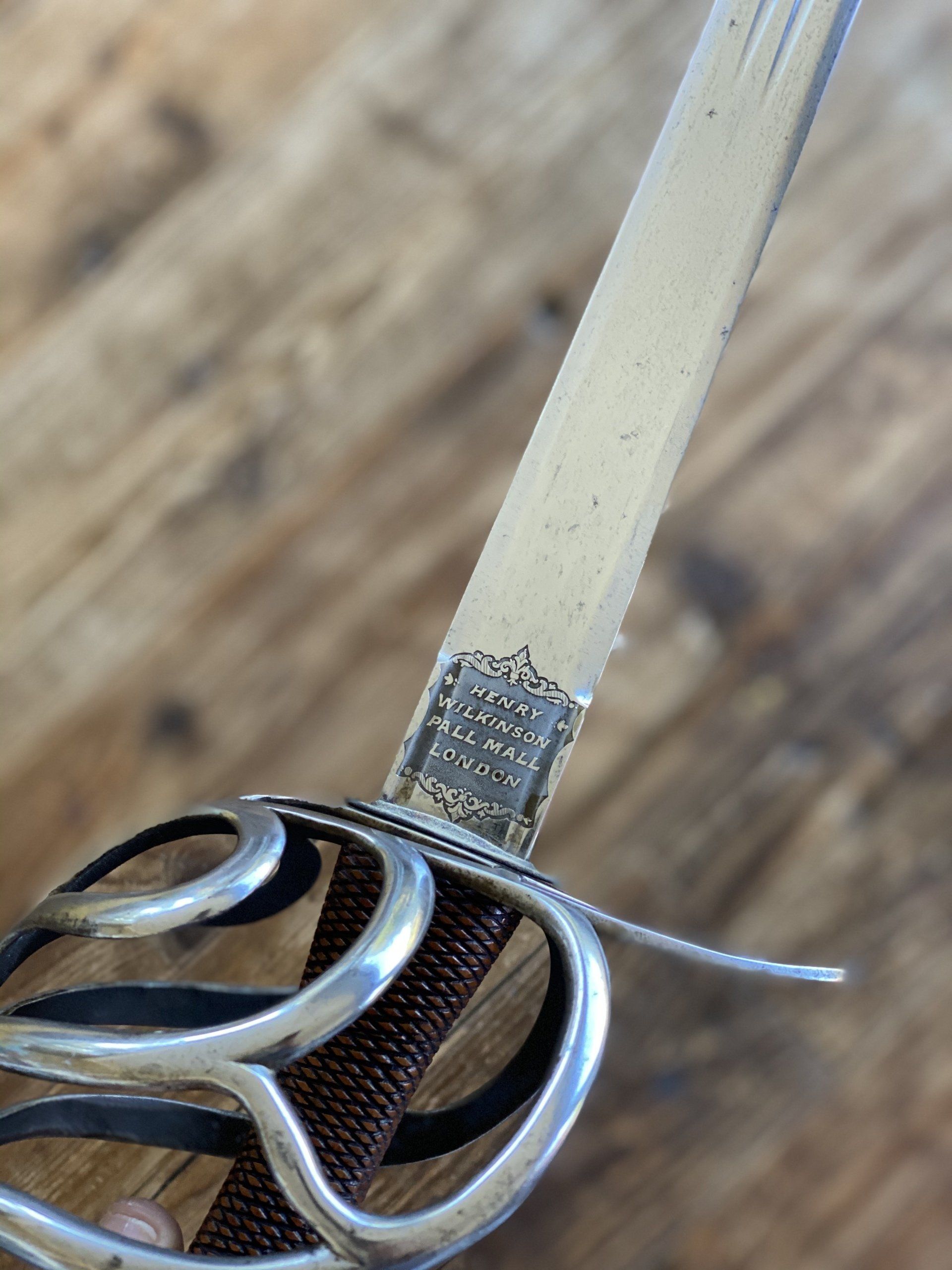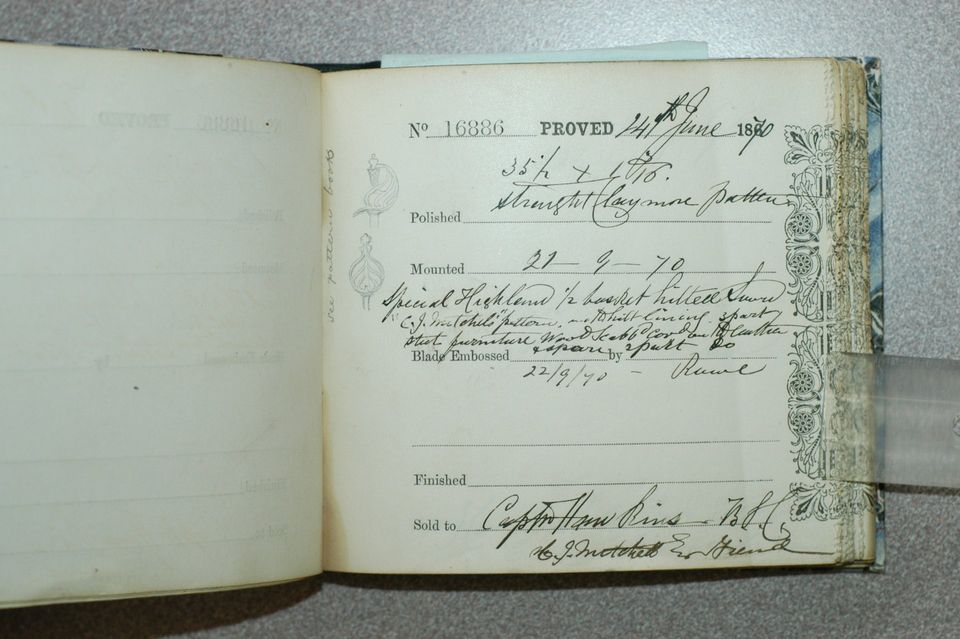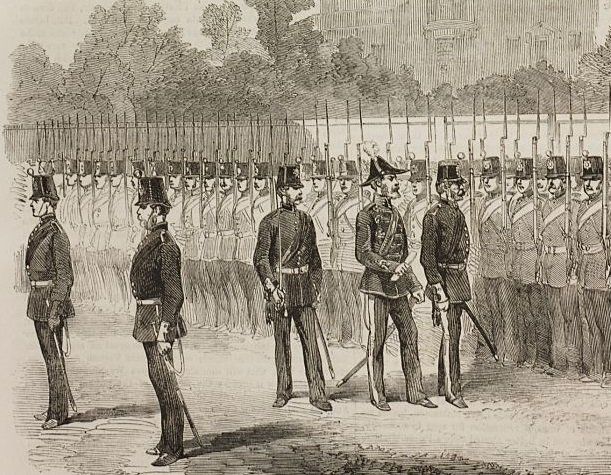Special order "CJM pattern" swords by WilkinsonBy Matt Easton
The natural assumption from this hilt type would be that this sword was for a light cavalry or artillery officer, but in fact infantry officers in India did sometimes use cavalry styles of hilt (and even Highland infantry officers did sometimes), which they considered to offer better hand protection in an environment where they were more likely to get into close combat than a typical European officer.
In several period photos we can see officers of native infantry carrying swords with hilts that we normally associate with cavalry service. Of course it should also be mentioned that infantry officers might be spending considerable amounts of time on horseback anyway, which may or may not have played a part in their sword choices.
Given the detail by Wilkinson to put blade sectional diagrams and notes on their record for Gordon's sword No.23506 of 1880, we might speculate that this was the first blade made to order like this and so this was not yet known as the "C. J. M Pattern", while subsequent examples made would refer back to it. We know that this sword was given by "C. J. M" from the blade etching, after all. So far, no earlier example has come to light.
However, was this "C. J. M pattern" a blade, a hilt, or both? Or was it simply any sword designed by the mysterious "C. J. M"? This remains slightly obscure.
These two swords (23506 and 24205), by themselves, would probably not get us closer to who C. J. M was, but luckily other records and a final sword would fill in the missing pieces of the jigsaw.
The mysterious C. J. M revealed!
In the book 'Wilkinson Sword Patterns & Blade Rubs' by my acquaintance and legendary researcher Robert Wilkinson-Latham (also a descendant of John Latham, and former employee of the Wilkinson Sword Company), available through Pooley Sword, appears (p.16) a very particular sword numbered 16886, of non-regulation design, and dating to 1870 (ten years earlier than the previous swords discussed).
This sword was previously only known to researchers through this record from the Wilkinson Sword Company. However, in 2018 the actual sword itself came to light, having emerged in an auction in Norway. It is now in the possession of a fellow sword collector, who has kindly provided these photos below for this article.
Every part of the sword is non-regulation, having a symmetrical basket-hilt which is very clearly modelled on the 1788 pattern heavy cavalry sword hilt, a walnut chequered grip of a type associated with specially-order Indian service swords, and a blade which is based on the Highland officer's broadsword (known as claymore in this period) blade, but elongated and given a more acute point.
The pattern book drawings show that the hilt was originally fitted with a removable liner (and this is mentioned in the proof book), which filled the gaps between the lateral bars and tied, like a Highland claymore hilt, near the pommel.
This sword was purchased in 1870 by Captain Francis Dempster Hawkins of the Bengal Staff Corps, who was then in command of the 4th Punjab Cavalry (research credit to Dr. Jordan Pryce Lewis and Gordon Byrne on Swordforum International).
A postcard of the 4th Punjab Cavalry in 1855, by William Carpenter:
Also on the records (both the sales ledger and the pattern book) another person is mentioned - "C. J. Mitchell Esq, friend".
Furthermore, the Wilkinson records refer to 'C. J. Mitchell's pattern'.
So, our C. J. M was Mitchell! - he had been right there, hiding in plain sight all along. It seems that Mitchell was designing swords, and in some cases giving them as gifts, at least between 1870 and 1881 (though his involvement with Wilkinson seems to have been longer than that).
The Wilkinson proof book entry reads (my transcription, as best I can manage):
No. 16886 PROVED 14th June 1870
[Blade] 35 1/2 x 1 1/16 [inches]
Straight Claymore Pattern [blade]
Mounted 21-9-1870
See pattern books [vertical note with two hilt drawings)
Special Highland 1/2 basket hilted sword [hilt]
"C. J. Mitchel's" pattern with hilt lining.
3 part steel furniture wood scabbard covered with leather
& spare 2 part ditto
Sold to Captain Hawkins B.S.C [Bengal Staff Corps]
C. J. Mitchell Esq's friend
Robert Willkinson-Latham adds the footnote in 'Wilkinson Sword Patterns & Blade Rubs':
"C. J. Mitchell was an agent and customer of Wilkinsons and made numerous purchases etc., his name appearing on many a Proof Book stub. He was also a good friend to Wilkinsons and John Latham, loaning money to the company at various times in the period 1865 to 1885."
Our C. J. Mitchell was heavily involved with Wilkinsons, designing special swords, giving them as gifts, as well as being a friend to John Latham and, as it transpires, preventing the company from collapsing.
Turning to one of Robert Wilkinson-Latham's other books, 'Mr Wilkinson of Pall Mall, Volume One 1772-1899" (available through Pooley Sword), we can see various correspondences between John Latham and C. J. Mitchell and we find out that in February 1880 it was C. J. Mitchell's financial assistance that essentially saved the company when it was on the brink of financial ruin, due to the stipulations put in place on the company finances by Henry Wilkinson before his death.
Finally, in one reference we see Mitchell's full name given as Charles James Mitchell.
With this information I started my search, to see if as well as pulling these strands together I could add some new research. I can now for the first time give some more information about Mitchell himself for future researchers:
Charles James Mitchell
Charles James Mitchell, Esq, was born in 1815, the son of Peter Mitchell, Esq. and Sarah Mitchell, of Camberwell. He worked as a stock broker at the London Stock Exchange and clearly became very wealthy. He came to reside at 90 Queen's Gate, South Kensington, London.
As well as being financially successful, he obviously had an interest in the military and in October 1852 became a Lieutenant in the Royal London Regiment of Militia.
On 27 December 1855, Mitchell married at St. Pancras, Louisa Harriett, the second daughter of Reverend Edward Osborn, the Vicar of Asheldam in Essex.
In May 1860, Mitchell chose to resign from the Royal London Militia, in order to become an Ensign in Queen Victoria's Rifles. The Victoria Rifles, raised in 1860 and associated with the King's Royal Rifle Corps, were one of the first and most senior branches of the new Rifle Volunteer movement, which had started in 1859/1860.
Rifle Volunteers were generally considered as more elite than the militias - they had newer rifled firearms and uniforms based on those of the Rifle Brigade and King's Royal Rifle Corps, who were considered as elite infantry forces of their time.
In this context, Mitchell's decision to give up a higher rank in the militia, in order to join at the lowest officer rank in the Victoria Rifles, makes sense.
The Volunteer Rifles movement had exploded in 1859/1860 due to a combination of factors, including the perceived threat of invasion from France and the beginning of a period of reform in the British armed forces, in the wake of the Crimean War and Indian Mutiny. One of the first officers of the Victoria Rifles was Captain Hans Busk, who had been a key lobbyer in encouraging the Government to raise the Volunteer Force.
In September 1863, Mitchell was promoted to Lieutenant in Queen Victoria's Rifles and in August 1864 he was promoted to Captain, as reported in the Army and Navy Gazette:
A contemporary officer in Queen Victoria's Rifles of 1862:
We know from the Wilkinson records, that during the period 1865-1884, Mitchell continued his financial business and provided financial support to John Latham and the Wilkinson company even after John Latham's death in December 1880.
It is also evident that Mitchell was designing, ordering and gifting swords to military officers during this period.
Some recipients of Mitchell's swords were probably family or friends, perhaps some were the sons of business associates or clients. It is easy to imagine how someone involved with finance, moving in his social circles, being enthusiastically involved with the Wilkinson company and also in the Volunteer movement, probably had any number of reasons to be giving swords as gifts.
Charles James Mitchell died on 14 April 1884 at 90 Queen's Gate, aged 69.
He left a widow, Louisa Harriett Mitchell, who herself died on 8 July 1887, also at 90 Queen's Gate.
Some other family notes:
- Father: Peter Mitchell, Esq., North Terrace, Camberwell, d. 27 Oct 1850 (age 81)
- Mother: Sarah Mitchell, North Terrace, Camberwell, d. 10 April 1863
- Only Sister: Anna Mitchell, North Terrace, Camberwell, d. 12 July 1876
- Eldest Brother: Peter Stanton Mitchell (b. 26 Dec 1805, d. 21 Aug 1879) - m1. Ellen (d. 7 Jan 1855, daughter of Stephen N Barber Esq, of Denmark Hill, Surrey), m2. Sophy (m. 18 June 1856, second daughter of Charles Edward Waller, Esq. of the Bank of England) - Resident of Clapham Park/Upper Clapton and later 100 Marina, St. Leonard's, engaged in charitable causes.
- Son: Percy Mitchell of The Hall, Cranford, Northamptonshire, died age 39 on 17 December 1902, in Harbledown, Kent. Percy also held estates at Massbrook, County Mayo. He was J.P. High Sheriff of Northamptonshire from 1896.
Another curious feature on my own example (23506) appears in the decorative etching on the blade. There are no monarch's cypher or other usual symbols, but instead there appears a phoenix and an urn full of fruit on both sides of the blade (shown below).
My first thought was that these might relate to the crests of the giver and receiver, and indeed it does seem that there are phoenix crests associated with the Mitchell name. I have not however been able to establish what the urn represents, if anything. Perhaps it is simply alluding to the giving of a gift, or perhaps it has some specific personal reference. This aspect of my research requires some further work.
Conclusion
Hopefully with time we will find out more about Charles James Mitchell and, if we are lucky, some more of the swords associated with him will come to light. I feel that with his long association and keen interest, there must be others of his swords surviving out there.
It remains an open question as to what exactly the 'C. J. Mitchell pattern' was. Was it a type of blade, a type of hilt, the combination of a set of features, or was it simply any sword which he designed to give someone? Was it perhaps an evolving thing, and what Wilkinsons considered his pattern in 1870 was not the same as in 1881, after a series of developments?
It seems that in 1881 the Rolt sword more or less emulated the design set out in 1880 with the Gordon sword. But the earlier 1870 Hawkins sword is quite different, having an archaic 1788 pattern guard, a totally bespoke modern grip and distinct pommel, and a blade rather more like a contemporary claymore, but stretched into rapier-like proportions.
Despite the variations however, there are some common features, which tell us quite a bit about Mitchell's opinions on swords.
Clearly, he preferred straight blades with good thrusting capacity and spear-points. While not being entirely dedicated thrusting blades and retaining a reasonably good cutting ability, these were good tried and tested cut and thrust blade designs of the previous two centuries. Clearly, he liked double-edged points, either to make thrusting more effective or perhaps to increase the use of false-edge cuts.
Mitchell seems to have had a real penchant for swords which harked back to 18th century models. We should remember that he was born in 1815 and in his childhood 18th century swords were probably still around in abundance. Perhaps his father or grandfather had a favourite basket-hilted broadsword or backsword and this made an impression on him. With links to estates in Ireland, perhaps he grew up around antique swords and was inspired by them.
Notably, it is clear that Mitchell thought that guards should be symmetrical and very protective. The 1870 Hawkins sword, as well as being modelled on the 1788 basket guard, was even equipped with a leather liner originally, like a Highland officer's broadsword. For service in India this made a lot of sense and numerous authorities on swords and swordsmanship had spoken of the virtues of basket hilts.
The drawback of conventional Highland basket hilts was a degree of restriction to the hand (caused by the side bars joining the pommel), but Mitchell's designs that we can see here all avoid that issue, by having only one junction between the basket and the pommel (at the front knucklebow). Mitchell clearly had strong ideas and was well informed on sword design and use.
Having the side bars connecting to the front (knucklebow) of the guard leaves great grip mobility and means that the sword can still be used like a conventional sabre of the day.
It is also entirely possible that his views on symmetrical guards were related to cutting mechanics, as extolled by John Latham and Colonel Marey-Monge, as much as protectiveness.
The hunt for more information, both on Mitchell and his sword designs, continues.
Special thanks to Dr. Jordan Pryce Lewis and Gordon Byrne for sharing their resources, and to Bob Hedger of Michael D Long Ltd for allowing me to use his photos here.
Copyright Matt Easton 2021










